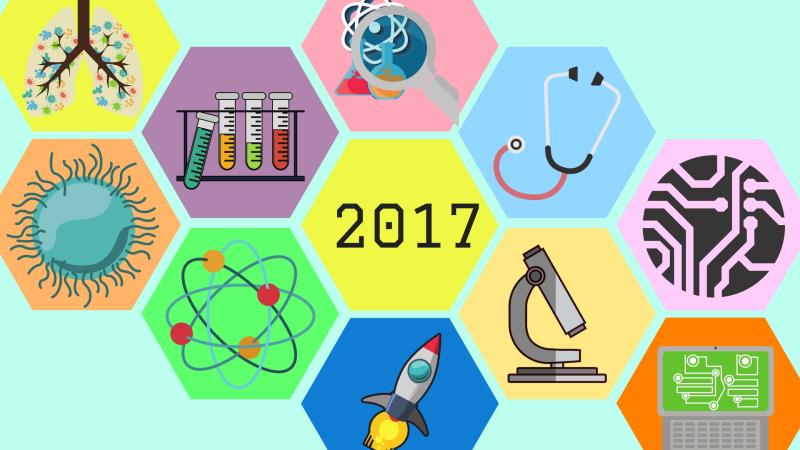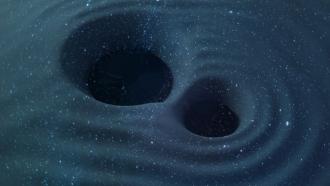
The year 2017 saw some tremendous breakthroughs in science. From genetic engineering, to quantum computing, to anthropology and climate science, some discoveries have left us in awe, and some have indeed pronounced a word of caution. As we draw down the curtains on this magnificent year, here is a snapshot on some of the remarkable contributions to science, in no particular order.
1. Scientists create the first ever stable compound from helium
Chemistry tells us that helium, the most abundant element in the Universe, does not react with any other elements or compounds. Hence the name ‘noble’ or ‘inert’ gas. In a study published in the journal Nature Chemistry, researchers have proved this false. They have discovered the first ever stable compound from helium with sodium, at very high pressures. With a chemical formula of Na2He, the compound is surprisingly not formed by chemical bonds. Here, electrons fill up the voids in the sodium cubes, holding the compound together and making it an insulator. This breakthrough research may help in understanding more about helium.
2. Inching closer to realising a quantum computer
The world is expecting a revolution with the advent of ‘quantum computing’ that promises to be faster by many million times than the best computers at present. Here, instead of electronic signals, quantum-mechanical properties of electrons like superposition and entanglement are used for computing. Theorised for many years, a new study by researchers at the University of Sussex might help us soon see one in action. The researchers have unveiled the first blueprint of a quantum computer, with details of its design and architecture. They are currently building a prototype based on this blue-print and hope to build a full-scale quantum computer in a decade.
3. First pill with a sensor approved for use
In a breakthrough in the field of medicine, the US Food and Drug Administration (USFDA) has approved the use of ‘Abilify MyCite', a pill with a sensor that digitally tracks if patients have ingested their medication. Prescribed to patients with mental disorders like schizophrenia, the pill marks the first drug in the U.S. with a digital ingestion tracking system. It works by sending a message from the pill’s sensor to a wearable patch, which then transmits the information to a mobile application so that patients can track the ingestion of the medication on their smartphone.
4. Detection of two more gravitational waves, and a Nobel Prize
The year 2016 stood out as a remarkable year for astrophysicists as the first evidence of the long predicted ‘gravitational waves’ was discovered. This year, not surprisingly, Rainer Weiss, Barry Barish and Kip Thorne, who set up the the Laser Interferometer Gravitational-Wave Observatory, (LIGO), won the Nobel Prize in Physics. To add to the body of evidence on gravitational waves, LIGO detected a third gravitational wave produced by merging black holes. After the Virgo interferometer from Europe joined LIGO, another gravitational wave was detected arising from the merger of two neutron stars.
5. Rewriting the history of human migration
A few discoveries in the year have altered our understanding of human migration from Africa. A study based on radiocarbon dating has now provided evidence that humans first entered North America by crossing the Bering Strait around 24,000 BP (Before Present), 10,000 years earlier than previously thought. In another study, researchers say that Homo sapiens may have migrated out of Africa 270,000 years ago, instead of 70,000 years ago once believed. In yet another study based on fossil evidence found at Jebel Irhoud, Morocco, scientists say that Homo sapiens may have originated about 300,000 years ago, over 100,000 years earlier than previously thought. In addition, an archaeological study states that Aboriginal people have been in Australia for at least 65,000 years, suggesting the arrival of humans on the continent was up to 18,000 years earlier than previously thought.
6. Are we closer to finding extraterrestrial life?
Our search for extraterrestrials may soon find an answer, thanks to the discovery of an exoplanet, which astronomers believe is best ever candidate in the search for extraterrestrial life. A new study has reported the discovery of LHS 1140b, a rocky “super-Earth”, a planet whose mass is greater than the Earth. Present in the habitable zone of a red dwarf star called LHS 1140, in the Cetus constellation, this planet is thought to have had a magma ocean on it surface millions of years ago. This lava could have then fed steam into the atmosphere, hinting at the presence of water, resulting in favourable conditions for life to exist.
7. The story of climate change gets gory
Climate change is real and it is here and 2017 saw a series of studies reckoning this. First, a study debunked the idea of pause in increase of sea temperatures and confirmed that our ocean temperatures have been steadily increasing in the past 75 years. Then, another study revealed that human activities are changing the climate 170 times faster than natural processes -- an alarming pace indeed. Yet another study has found that oxygen levels in the oceans have declined by 2% globally in the last 50 years due to warming and stratification. Increasing global temperatures has affected glaciers all over the world and scientists predict that at least a third of Asia's mountain glaciers will be lost by 2100. Oceans are warming 13% faster than previously thought, and satellite record of lower tropospheric temperature shows nearly 30% faster warming since 1979.
8. Human embryo edited for perfection
What was once a fantasy with gene editing, has now turned into reality. Amidst cautions on the consequences of editing our DNA, researchers at the Salk Institute created the first human-pig hybrid embryo, containing genetic information from both species. In another study, scientists in the US claim to have altered the DNA code of a human embryo for the first time using CRISPR, a family of DNA sequences in bacteria used for gene editing. In a process called ‘germline engineering’, scientists claim that the edited sequence will now be passed on to the offsprings, thus eradicating the possibility of disease carrying genes found in the offsprings. Following this, in yet another study, scientists have corrected a disease-causing mutation for a heart condition in the early stages of a human embryo with gene editing. These breakthroughs may put to rest genetic defects, thus promising a bright future free from congenital genetic disorders. Perhaps, we might soon have the ‘perfect’ human!
9. Metallic hydrogen, theorised for almost a century, becomes reality
It was 1935 when Wigner and Huntington predicted that molecular hydrogen could turn into an atomic metal at a pressure of 25 GPa. Eighty years on, a new study has made this possible by producing the first metallic hydrogen at low temperature and high pressure. Considered a great challenge in condensed matter physics, the production of metallic hydrogen could answer fundamental questions about the nature of matter. In addition, it has immense potential as a ‘room-temperature superconductor’ -- a material that offers no resistance to electricity at room temperatures -- thus revolutionizing the fields of energy and rocketry.
10. Scientists decipher what is causing a geoid low in the Indian Ocean
Oceans have a lot of mysteries buried deep inside and scientists have unearthed one such mystery in the Indian Ocean--the mystery of the missing mass. In a pathbreaking seismological study, researchers have examined the Indian Ocean Geoid Low (IOGL), a point of abnormally low gravity, caused by the deficit in the mass of Earth below IOGL. While there were a few theories in the past explaining the cause, none of them were convincing. Now, in a new study published this year, scientists from India and Germany seem to have finally succeed in their attempt to explain this phenomenon. They suggest that lighter material, present in the upper and mid-mantle (the layer below the Earth’s crust) just below the IOGL, could be responsible for this anomaly. The researchers used various seismographic tools and computer analyses, to providing a satisfying explanation for a long standing mystery, putting to rest all speculations.
11. A look into the deep space:
The year 2017 witnessed quite a few successful launches of space probes and satellites. India's very own ISRO (Indian Space Research Organisation) set a world record with a successful launch of 104 satellites in one go with its PSLV C37 rocket. The other highlight of the year was the long goodbye to Cassini, a mission to Saturn, which plunged into the planet's rings, ending its journey of two decades. NASA also made some great headways in understanding Ceres, the closest dwarf planet to Earth, and detected traces of organic molecules through its mission Darwin. The Curiosity mission, walking on Mars, found evidences on an ancient lake on the planet that may have harboured life. NASA's Juno spacecraft, studying Jupiter, took a close look at the planet's famed Red Spot. The agency also announced the launch of 4 more probes to different destinations in the cosmos in the years to come.

























